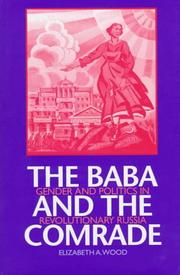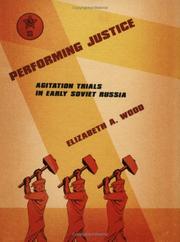| Listing 1 - 10 of 33 | << page >> |
Sort by
|
Book
ISBN: 1003347711 1000850307 1003347711 1032367148 1032389575 Year: 2023 Publisher: Milton Taylor & Francis Group
Abstract | Keywords | Export | Availability | Bookmark
 Loading...
Loading...Choose an application
- Reference Manager
- EndNote
- RefWorks (Direct export to RefWorks)

ISBN: 0253333113 0585001073 9780585001074 9780253333117 Year: 1997 Volume: *1 Publisher: Bloomington Indiana University Press
Abstract | Keywords | Export | Availability | Bookmark
 Loading...
Loading...Choose an application
- Reference Manager
- EndNote
- RefWorks (Direct export to RefWorks)
Women and communism --- Women --- History --- Political activity --- Soviet Union --- Women in politics --- Women in politics - Soviet Union - History.

ISBN: 1501711474 9781501711473 0801442575 9780801442575 Year: 2018 Publisher: Ithaca, NY : Cornell University Press,
Abstract | Keywords | Export | Availability | Bookmark
 Loading...
Loading...Choose an application
- Reference Manager
- EndNote
- RefWorks (Direct export to RefWorks)
After seizing power in 1917, the Bolshevik regime faced the daunting task of educating and bringing culture to the vast and often illiterate mass of Soviet soldiers, workers, and peasants. As part of this campaign, civilian educators and political instructors in the military developed didactic theatrical fictions performed in workers' and soldiers' clubs in the years from 1919 to 1933. The subjects addressed included politics, religion, agronomy, health, sexuality, and literature. The trials were designed to permit staging by amateurs at low cost, thus engaging the citizenry in their own remaking. In reconstructing the history of the so-called agitation trials and placing them in a rich social context, Elizabeth A. Wood makes a major contribution to rethinking the first decade of Soviet history. Her book traces the arc by which a regime's campaign to educate the masses by entertaining and disciplining them culminated in a policy of brute shaming.Over the course of the 1920s, the nature of the trials changed, and this process is one of the main themes of the later chapters of Wood's book. Rather than humanizing difficult issues, the trials increasingly made their subjects (alcoholics, boys who smoked, truants) into objects of shame and dismissal. By the end of the decade and the early 1930s, the trials had become weapons for enforcing social and political conformity. Their texts were still fictional-indeed, fantastical-but the actors and the verdicts were now all too real.
Book
ISBN: 9781032389578 9781032367149 Year: 2023 Publisher: Abingdon, Oxon ; New York, NY : Routledge,
Abstract | Keywords | Export | Availability | Bookmark
 Loading...
Loading...Choose an application
- Reference Manager
- EndNote
- RefWorks (Direct export to RefWorks)
"A New Role for Museum Educators shows how that learning happens in communities, how volunteers and professionals approach their work, the underlying principles and philosophies that guide the work of museum education, and how these are always evolving to remain relevant. Museum education in its most expansive definition is about communicating messages, creating learning experiences and, at its most aspirational, promoting human development for people of all backgrounds, abilities, and circumstances. This edited volume revisits the legacy of museum education practices, reflecting on the changing context of community and the role of cultural institutions, and provides insights into new directions that museums can take with a visitor-centered mindset. It provides foundational concepts around educational philosophies that guide practice, applied methods and approaches for implementation, and the ethos of an educational institution intended to support community learning and engagement that are essential to provide for the wide-ranging needs of all audiences. International perspectives from a variety of museums are considered, including art museums, children's museums, history museums and historic sites, science museums, botanical gardens, zoos and aquariums. Chapters included thought-provoking reflections on contemporary practices, concrete examples from across the globe, and useful tools for anyone working with public audiences. Grounded in practice and informed by research, this volume will be a go-to resource for arts and cultural organization practitioners, particularly those working in Museum Education. It will also be essential reading for students of Museum Studies, Education, and related fields"--
Museums --- Museums and community. --- Educational aspects. --- Social aspects.
Book
Year: 1964 Publisher: New York: Van Nostrand,
Abstract | Keywords | Export | Availability | Bookmark
 Loading...
Loading...Choose an application
- Reference Manager
- EndNote
- RefWorks (Direct export to RefWorks)
Book
Year: 1963 Publisher: New York: Columbia university press,
Abstract | Keywords | Export | Availability | Bookmark
 Loading...
Loading...Choose an application
- Reference Manager
- EndNote
- RefWorks (Direct export to RefWorks)
Book
Year: 1964 Publisher: Princeton (N.J.) : Van Nostrand,
Abstract | Keywords | Export | Availability | Bookmark
 Loading...
Loading...Choose an application
- Reference Manager
- EndNote
- RefWorks (Direct export to RefWorks)
Book
Year: 1964 Publisher: Princeton, N.J. Van Nostrand
Abstract | Keywords | Export | Availability | Bookmark
 Loading...
Loading...Choose an application
- Reference Manager
- EndNote
- RefWorks (Direct export to RefWorks)
Book
ISBN: 0713129573 Year: 1987 Publisher: London : E. Arnold,
Abstract | Keywords | Export | Availability | Bookmark
 Loading...
Loading...Choose an application
- Reference Manager
- EndNote
- RefWorks (Direct export to RefWorks)
Book
Year: 1963 Publisher: New York : Columbia University Press,
Abstract | Keywords | Export | Availability | Bookmark
 Loading...
Loading...Choose an application
- Reference Manager
- EndNote
- RefWorks (Direct export to RefWorks)
| Listing 1 - 10 of 33 | << page >> |
Sort by
|

 Search
Search Feedback
Feedback About UniCat
About UniCat  Help
Help News
News